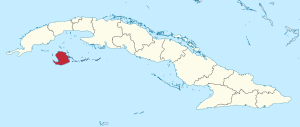Battle of Pinos facts for kids
Quick facts for kids Battle of Pinos |
|||||||
|---|---|---|---|---|---|---|---|
| Part of the Anglo-Spanish War (1585) | |||||||
 Location of Isla de Pinos (called Isla de la Juventud since 1978) in Cuba. |
|||||||
|
|||||||
| Belligerents | |||||||
| Commanders and leaders | |||||||
| Thomas Baskerville | Bernardino de Avellaneda | ||||||
| Strength | |||||||
| 14 warships | 13 galleons | ||||||
| Casualties and losses | |||||||
| 1 galleon captured 1 patache captured 325 killed or captured |
1 ship sunk 80 killed or wounded |
||||||
The Battle of Pinos was an important sea battle. It happened between a Spanish fleet and English ships. The battle took place off the Island of Pinos in 1596. This island is now part of Cuba.
The Spanish fleet was led by Admiral Bernardino Delgadillo y Avellaneda. The English ships were the remaining ones from Francis Drake's trip to the Spanish West Indies. After Drake's death, his officer, Sir Thomas Baskerville, took command. The Spanish fleet won this battle, capturing two English ships.
Why the Battle Happened
After trying to attack San Juan de Puerto Rico and Panamá, the English fleet faced big problems. Both Francis Drake and John Hawkins had died from a sickness called dysentery. This made the English fleet very sad and worried.
The English ships then went to Portobello to fix their vessels. They also needed to get organized before sailing back to England. Sir Thomas Baskerville was chosen as the new leader of the fleet. The number of English ships went down to 18. Two ships, the Delight and the Elizabeth, had to be burned or sunk. This was because there were not enough sailors left to crew them. Many leaders and sailors had died from fighting or sickness.
The English fleet left Portobello on February 8. A few days later, a big storm hit. It scattered the ships. Some ships went back to England by way of Jamaica. Baskerville, with most of the fleet, sailed towards Cabo Corrientes. His plan was to go home along the northern coast of Cuba.
Meanwhile, news of Drake's attack on Gran Canaria reached Spain. Spain sent a fleet of 8 large ships (galleons) and 13 other vessels. These ships were led by Captain General Don Bernardino de Avellaneda. They had about 3,000 men. This fleet was sent from Sevilla to Cuba. Spain thought Cuba might be in danger from the English. In early March, the Spanish fleet arrived at Cartagena de Indias. They were ready to chase Baskerville.
The Sea Battle Begins
On March 7, part of Avellaneda's fleet found two English ships. These ships were south of Cienfuegos. They were the Pegasine and were led by Thomas Maynarde. The Spanish ships attacked them. The English ships were badly damaged. But they managed to get away by avoiding dangerous shallow areas near Pinar del Río. They reached England on May 3.
Just one week later, Avellaneda found the main English fleet. The English were getting wood and water at Guaniguanicos Cove. This was in the Island of Pinos, south of Cuba. Avellaneda immediately ordered his ships to raise their flags and attack.
Baskerville's main ship was John Hawkin's La Garlande. He tried to avoid fighting. He ordered his ships to scatter towards Cape San Antonio. Most of the English ships escaped. They threw their small boats and luggage into the water to move faster.
However, three Spanish ships, led by Vice Admiral Juan Gutiérrez de Garibay, caught two English ships. They captured a large English ship (a galleon) with 300 men. They also captured a smaller ship (a patache) with 25 men. The captured English sailors were sent to work on the defenses of Havana. The Spanish lost about 80 men who were killed or hurt. One Spanish warship also sank during the fight.
What Happened Next
Avellaneda's fleet chased the English ships. They followed them as far as the Old Bahama Channel. On May 22, while returning to Havana, the Spanish captured another English ship. This was John Crosse’s small ship, the Little Exchange.
This was not the last loss for the English. Only eight of the 28 warships that left England in 1595 returned home. The surviving ships reached Plymouth at the same time. At the same time, the Spanish treasure fleet arrived in Sanlúcar de Barrameda. It carried 20 million silver dollars. This was one of the largest shipments of treasure ever to arrive from the Americas.

